Research Your Target List
You need to research your target list and do not rely on assumptions, beliefs or rumors. You need to get the facts.
This is the third in the series on the Targeted Job Search.
To read the rest of the Targeted Job Search series click here.
Step #2 in this process is to properly research the companies on your radar. Your goal is to find out if the company is somewhere you would want to work.
Start with some basic research:
- Check out each company’s website from your target list. Particularly, check out the press release section. Here, you will find press releases for financials, if it is a public company. If it is a start-up company, you will want to look for press releases for funding announcements.
- Check out all of the companies on your target list on Glassdoor. You will want to take the reviews on Glassdoor with a grain of salt. Read this latest article on Recruiter.com titled “Should Employers Fear Glassdoor Reviews.”
- Perform a Google search on the company to see where the company is showing up on the Internet. You may want to set up a Google Alert for the company name.
Connect on LinkedIn with Current Employees
You are looking for people who look, taste and smell like you. You want to locate people who perform the job you are looking for, with similar credentials and educational background, and have the same generational, gender or other identifiable characteristics. If you are someone in the 2nd half of life, you want to see if they hire people like you.
You start out by locating employees by either certification or job title from your target list.
The process I have had clients follow is the following:
- Go to LinkedIn Search
- Open up the Keywords drop-down menu and type the certification letters that you have (PMI or SPHR or CCNA, etc.) in the Last Name field OR the various combinations of job titles that you are looking for in the Title field.
- Enter the company name in the Current Companies field and select the company that most closely matches the organization that you are searching for. Sometimes you will find different divisions within the same company listed separately.
- Type your location into the Locations menu. If your location does not appear, click on the “+” option and type in your location. You will need to select the geographic location that most closely matches the location where you want to work.
- Click on Search
You now may want to refine the search based on keywords.
Using LinkedIn, locate people in the company who you are either a 1st or 2nd-degree connection.
1st-degree connections are people you are directly connected to and I would suggest you contact them immediately. Your goal is to start a conversation about how they like working for the company and to ask for some advice. Advice is the magic word in this conversation.
For 2nd-degree, connections will want to select a common connection and ask them how well they know the individual and whether they would be willing to make an introduction. You are looking for an introduction.
You may have to approach multiple connections for 2nd-degree connections. Be persistent.
 For 3rd-degree connections, you may want to send a cold connection request stating you would like to ask them about their experiences at the company. You will find the connect option under the “…” symbol to the right of the name. See image to the right.
For 3rd-degree connections, you may want to send a cold connection request stating you would like to ask them about their experiences at the company. You will find the connect option under the “…” symbol to the right of the name. See image to the right.
Once you have an introduction, schedule a phone call to plan to meet for coffee or lunch in order to ask them for AIR – Advice, Insights and Recommendations! Like I stated above, “advice” is the magic word. It is a compliment and people will rarely turn you down.
You are not looking for a job. You want to find out whether they like working there. What are the good and bad points about working there? Lastly, you want to ask them – who should I talk to next or who can you introduce me to learn more?
It is the last step, asking for the recommendation, that people will most often forget.
Connect with them on LinkedIn.
Connect on LinkedIn with Past Employees
Follow the same process for past employees except using the Past Companies drop-down menu. Go through the list of profiles to find those who recently left the company. This could be individuals who left within the last year.
Your goal is to ask these individuals why they left the company.
I have a client who had applied for a senior level HR position with a local company that had recently gone public. We located 3 people who had left within the last year. My client sent connection requests to all 3 individuals and wrote in the connection request that he would like to chat with them about their experiences at the target company. All 3 immediately accepted and agreed to chat with him on the phone.
Why did they leave? All three had the same answer. Toxic work environment.
My client interviewed for the position, received an offer and turned it down.
Similarly, I had a client who was interested in a company where the company founder had left after 10 years at the company. I was able to arrange an introduction to the company founder, and he told my client it was time to move on. He had nothing but glowing things to say about the company.
You may get a very different view of the company from former employees.
In the process make sure to connect with all these individuals on LinkedIn.
Magic Word is Advice
If you approach these individuals asking for advice rather than asking for a job, most of them will be receptive.
When did you turn anyone down when someone asked you for advice?
The next step in the process is to connect with recruiters.
To read the rest of the Targeted Job Search series click here.
Marc MillerLike What Your Read? Get Career Pivot Insights
Do You Need Help With ...

Check out our Help Center where you have access to 14 different content portals.


